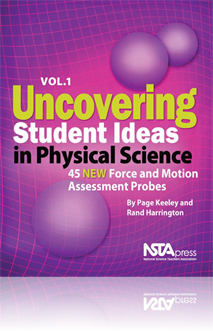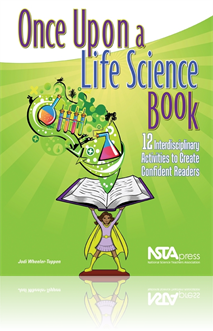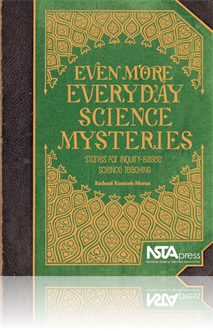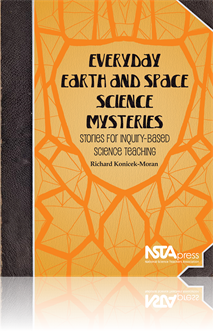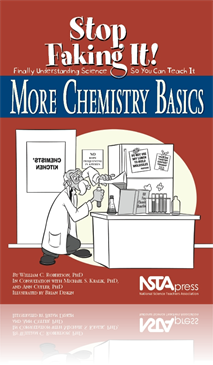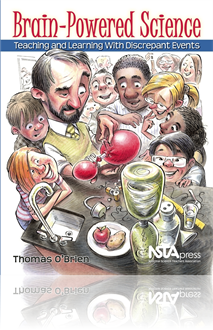All Book Chapters
Book Chapter
The purpose of this assessment probe is to elicit ideas about uniform motion. The probe is designed as a starting point to encourage students to use evidence and observation to support their ideas. The goal is for students to eventually develop and t...
Book Chapter
The topic of plants does not excite many middle school students. Learning about the inner workings of xylem and phloem feels far removed from any practical applications in their lives. This chapter uses a (true life!) crime scenario to frame the stud...
Book Chapter
This book, and particularly the stories which lie within, provide an opportunity for students to take ownership of their learning and learn science in a way that will give them a more positive attitude about science. In addition, it will serve to hel...
Book Chapter
Most students are totally unaware of the amount of sugar in bubble gum and don’t know that they are literally eating sugar in huge amounts. In this chapter, the author is concerned with finding out what happens to the weight of gum when it is chewe...
Book Chapter
What happens when seeds are soaked in water, you may find that your students cannot perceive of seeds absorbing so much water, for they may equate the seeds with how a sponge soaks up water. The story in this chapter offers students an opportunity to...
Book Chapter
Children may not be aware of what is exactly happening when they have their pulse taken by a doctor or nurse or even why it is important. The story in this chapter is aimed at helping children discover what kinds of activities change their heart rate...
Book Chapter
Students are usually aware that seed plants have adapted to overcrowding by developing mechanisms that disperse their seeds to other locations. In this chapter, the story explores one of the important characteristics of plant evolution, the wide dist...
Book Chapter
Students may well have the usual “bigger is better” conception about comparing different items. Pumpkins are the perfect object to help engage students in investigative science and answer most of their questions by direct observation. ...
Book Chapter
Do your students believe that an insulating substance such as wool can actually produce heat? The story in this chapter is designed to motivate your students to let you know what they believe and then for them to be able to test their theories in the...
Book Chapter
Most children have a difficult time believing that air has mass and takes up space, so the concept of water vapor floating in the air is just as problematic. The story in this chapter helps provide an opportunity to explore this phenomenon and to lea...
Book Chapter
Some students are not aware that an object weighs as much as the sum of its parts. The story in this chapter has two purposes. One is to allow students to test their ideas about the distribution of weight, and the other is to help them realize that w...
Book Chapter
Rust is one of the most common of every day phenomena, but again, is probably one of the least understood by students. The story in this chapter attempts to get students and their teachers involved in some tests to see what they can learn about rust ...
Book Chapter
Children think of floating or buoyancy in several ways. The purpose of the story in this chapter is to motivate students to solve the mystery of why objects bob up and down in carbonated drinks. ...
Book Chapter
Using the Book and the Stories
It is often difficult for overburdened teachers to develop lessons or activities that are compatible with the everyday life experiences of their students. A major premise of this book is that if students can see the real-life implications of science ...
Book Chapter
Using the Book in Different Ways
Although the book was originally designed for use with K–8 students by teachers or adults in informal settings, it became obvious that a book containing stories and content material for teachers who are intent on teaching in an inquiry mode had oth...
Book Chapter
There is currently a strong effort to combine science and literacy, because a growing body of research stresses the importance of language in learning science. Discussion, argumentation, discourse of all kinds, group consensus, and social interaction...
Book Chapter
Your students will probably not be aware of the amount of water that covers the Earth’s surface. The story in this chapter will help introduce students not only to a clearer idea of the characteristics of our planet, but also to the concepts of pro...
Book Chapter
It is not difficult to understand that students may have a misconception that the clocks we use are directly related to Sun time and that changing the clocks will alter the Sun-Earth time relationship. This chapter and story deal with this misconcept...
Book Chapter
Students may have the idea that all mountains are volcanoes and were formed by eruptions. The story in this chapter brings up questions about the geology of mountains and the weathering and erosion that takes place as nature breaks down the higher la...
Book Chapter
It is not difficult to understand that students may have a misconception that the clocks we use are directly related to Sun time and that changing the clocks will alter the Sun-Earth time relationship. This chapter and story deal with this misconcept...
Book Chapter
The title of this chapter is a compact way of saying that it covers two separate branches of chemistry. The first is electrochemistry and the second is the interaction of light with matter. An entire chapter could be spent on each of these areas, but...
Book Chapter
This is the second chemistry book in the Stop Faking It! series—the first one is Chemistry Basics. This book introduces new concepts and expands on many of the concepts presented in the first book, hence the author felt it would be helpful to begi...
Book Chapter
This chapter is about states of matter and a section of chemistry called thermodynamics which is the inspiration (or lack thereof) for the chapter title. The chapter might seem just a bit disconnected from the content in the rest of the book, but it�...
Book Chapter
To begin this chapter, you need to picture electrons in atoms as residing in orbitals—those fuzzy things that can be spherical, dumbbell-shaped, or even ring-shaped. The author addresses orbitals and why they’re fuzzy and then deals with how the ...
Book Chapter
The basics of chemical reactions were covered in the first chemistry book, including how to write and balance chemical equations that represent those reactions. There is also a quick review of chemical reactions in Chapter 1 of this book. We’re goi...
Book Chapter
Half a Life is Better Than None
Most of chemistry deals with chemical reactions and, hence, with how electrons in atoms behave either in single atoms or when those atoms get together with other atoms. There is a branch, though, that deals with the nuclei of atoms—and that’s wha...
Book Chapter
It would be impossible to investigate even a fraction of organic chemistry in this book, so in this chapter the author goes over a few things that will complement the limited organic chemistry in the first book. This is not a comprehensive chapter on...
Book Chapter
Many of your younger students do not believe that air around us has mass or weight, let alone exerts pressure on us and on everything around us. So, the idea that the atmosphere in which we walk actually has mass and can exert pressure on our world m...
Book Chapter
Analogies: Powerful Teaching-Learning Tools
In this activity, teachers explore how teaching shares some attributes with a variety of other occupations, students consider their respective roles as learners, and both consider the reciprocal, interactive nature of the teaching-learning partnershi...
Book Chapter
Talking Tapes: Beyond Hearing to Understanding
The need to combine fun, hands-on “play” with the mentally engaging, minds-on “work” of learning should be emphasized in professional development settings and in science methods courses. Teachers should emphasize frequently—in words that st...
Book Chapter
Super-Absorbent Polymers: Minds-On Learning and Brain "Growth"
Super-absorbent polymers (SAPs) absorb and retain water up to several hundred times their mass and increase in volume up to 600%. Unlike this prop, students’ brains do not grow/learn by passive absorption of received knowledge from the outside. Lea...
Book Chapter
Mental Puzzles, Memory, and Mnemonics: Seeking Patterns
Various mental puzzles and memory tasks can seem difficult until a heuristic or generalizable problem-solving technique is discovered or invented. A mnemonic (memory device) can help learners remember information. A heuristic or mnemonic can make an ...
Book Chapter
Sound Tube Toys: The Importance of Varying Stimuli
Sound is a form of energy created and transmitted as a vibration or mechanical wave that can vary in pitch (frequency) and volume (amplitude). Simple toys can be used to engage interest and to develop and assess the skills of scientific inquiry and t...
Book Chapter
Convection: Conceptual Change Teaching
Two bottles of different-colored water are placed vertically, one on top of the other with open ends together. They remain stable if the bottle with the hotter (red-colored) water is placed on top of the bottle with the cooler (blue-colored) water. I...
Book Chapter
Brain-Powered Lightbulb: Knowledge Transmission?
This activity explores the closed, battery-powered circuits that convert chemical potential energy to electrical energy to light energy. Since Edison’s invention of the lightbulb, it has been commonly used as a visual symbol of intelligence, ingenu...
Book Chapter
3D Magnetic Fields: Making Meaningful Connections
In this activity, a sealed, transparent container filled with a clear, colorless oil and several tablespoons of iron filings is shaken and a cylindrical magnet is suspended in the middle of the container. Beautiful magnetic field lines are made visua...
Book Chapter
Electric Generators: Connecting With Students
Most students have a very limited sense of where electricity comes from. In this activity, a hand-powered electric generator converts mechanical energy into direct current (DC) electricity that can be used to power a small lightbulb, run an electric ...
Book Chapter
Static Electricity: Charging Up Two-by-Four Teaching
Static electricity is created when two different insulating materials are rubbed together, creating friction that allows electrons to shift from one material to the other. In this activity, a 6-8 ft., 2 in. x 4 in. board balanced on a large watch gla...
Book Chapter
Möbius Strip: Connecting Teaching and Learning
A Möbius strip is a nonorientable, two-dimensional surface with only one side. The one-sided nature of the Möbius strip is an example of an emergent property—a property that is found in a system as a whole, but not in any part of the system. In t...
Book Chapter
Needle Through the Balloon: Skewering Misconceptions
Prior experiences and conceptions that students have about a wide variety of science phenomena (e.g., sharp needles pop balloons) often form barriers to developing more scientifically valid understandings. In this activity, a long needle is passed th...



